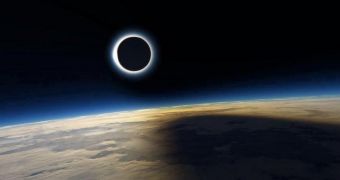It's a good thing the Stone Age is long over, otherwise quite a lot of people would probably go berserk this coming Tuesday, April 29. This is because, on said date, the moon is to cover up most of our sun, and only leave a bright ring visible.
Specialists explain that having the moon cover the sun to such an extent and turn it into a cool ring of fire, i.e. an annulus, is called an annular eclipse, Space informs.
According to the same source, the moon will only hide part of the sun from view on Tuesday due to the fact that our planet's satellite will at that time be quite far from Earth and, consequently, too small to cover the star in its entirety.
Thus, an annular solar eclipse is different from a total solar eclipse, when the moon manages to obscure the sun completely and hide it from view, scientists say.
Before sky-gazing enthusiasts run and clear their schedules for April 29, it must be said that, unfortunately, this spectacular annular eclipse will only be visible in a remote part of Antarctica, which also happens to be uninhabited.
Otherwise put, penguins and other creatures living in this part of the world will be the only ones to have front-row tickets to this event, even if they haven't exactly asked or paid for them.
However, specialists reassure that some lucky people across the world will nonetheless get the chance to witness partial phases of the phenomenon. Granted, most of these partial phases will be visible from certain areas in the ocean, but some patches of land will get to join in on the fun.
It is said that the island state of Tasmania will be the best place to be to observe next week's annular eclipse. Here, the moon is expected to worm its way across the sun's edge at 3:51 p.m. local time. Maximum eclipse is to be recorded as 5:00 p.m., and at 5:17 p.m. the sun will set.
What's more, word has it that the entire continent of Australia will get a pretty good view of the phenomenon, so folks who feel that they absolutely must see the eclipse might want to book a flight to this part of the world without delay.
Scientists stress that those who wish to observe partial phases of the eclipse must not look at the sun directly, and instead use proper filters provided by planetariums, science centers, and telescope stores.

 14 DAY TRIAL //
14 DAY TRIAL //